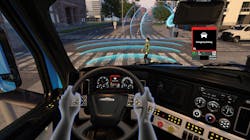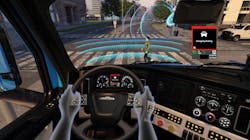Most common safety features on a commercial vehicle today provide warning capabilities, through functionality such as forward collision warning, lane departure warning, and blind spot monitoring. These systems provide audible and/or visual alerts in the vehicle cab to alert the driver about an impending incident.
The next evolution of safety systems involves system intervention, where the safety system will react if the driver does not. One example is automatic emergency braking. With this functionality, the system will apply brakes automatically in the event an object is detected and the driver does not actively engage the brake.
Kary Schaefer, general manager of product strategy and marketing for Daimler Trucks North America, discussed the evolution of commercial vehicle safety technologies during a General Session of the Truckload Carriers Association (TCA) Safety and Security Conference. The 39th annual conference, held June 23-25, has been offered to attendees virtually due to the COVID-19 pandemic.
The session, titled "Safety Truck of the Future," provided attendees information on current safety systems available for commercial trucks, how those safety systems have evolved, and what fleets can expect regarding truck safety systems in the future.
“Research shows that the vast majority of motor vehicle accidents are tied to human error, and safety systems that are available on the market today save lives and can reduce damage,” Schaefer said. She advised that specing safety systems on commercial vehicles can mitigate the instances and cost of crashes, help to increase vehicle uptime by reducing damage and repair times, and can improve driver comfort and safety.
Continued sensor and camera integration in safety systems
The next evolution of vehicle safety systems, which has allowed the commercial vehicle to intervene on behalf of the driver when an object is detected, includes object recognition through camera and sensor technology that works together, known as “fused technology.”
“Fused technology uses information from the radar and camera to detect, to classify and determine what objects are in the truck's path,” Schaefer advised. “When the camera and the radar work together in fusion, or in conjunction, object recognition is greatly increased. And this increase in object recognition can improve the braking, performance and object detection on moving or stationary vehicles, as well as moving pedestrians.”
Schaefer expects camera technology to advance to the point where driver-facing cameras will be integrated into the safety systems, in addition to surrounded view cameras and backup cameras integrated into commercial vehicle safety systems as well.
Advanced Driver Assistance Systems (ADAS), developed from active safety systems, have provided safety technology focused on offering an improved driver experience and comfort. Common ADAS features available on commercial vehicles today include:
- Active steering, a safety and fatigue-reducing feature which provides “micro-steering” functionality making slight adjustments to the steering wheel, especially noticeable at slow speeds and while backing the vehicle.
- Adaptive cruise control, which monitors objects immediately in front of the vehicle to maintain a similar and consistent speed and distance between other vehicles. In some systems this technology can bring the vehicle to 0 mph.
- Lane keep assistance, which keeps the vehicle centered in the lane with minimal effort from the driver.
- Automatic headlights, high beams and wiper blades, which “use sensors on the vehicle to detect ambient light detect rain, and they will automatically turn off or adjust the headlights and wipers depending on conditions,” advised Schaefer.
Outlook for future systems
Current commercial vehicle safety systems have primarily focused on improving safe operation while on the highway, advised Schaefer. The next evolution of safety system technology looks to reduce crashes in other operational settings. The next step: rural locations. Common accidents that occur in rural locations include cross path, or “T-bone” crashes, collisions caused by vehicles traveling in opposite directions, and rear vehicle strikes.
“These are typically accidents that happen in rural locations. Some are on-highway, but roughly two-thirds happened in rural locations,” Schaefer said. “The big next step in safety systems that we see is being able to address those other accident types.”
Schaefer discussed a number of new technologies on the horizon when it comes to commercial vehicle safety systems. These include blind spot warning and braking, and cross traffic mitigation, mirror cameras and external environment cameras.
Blind spot warning and braking may be particularly useful in more urban settings, suggested Schaefer. The blind spot warning and side guard assistance systems would detect and engage brakes if an object is detected in the path of the trailer.
“Imagine you're in a city or in an urban situation, there's a light pole or post, or another object,” Schafer said. “By having the blind spot or the side guard radars, fused, or integrated with the brake systems, you can avoid sideswipes and collision accidents by warning and braking the vehicle.”
With cross traffic mitigation, the system would monitor and detect if objects are in danger of striking either side of the commercial truck, using front and side radar. This can help reduce the number of cross path crashes that occur in locations such as stop signs or poorly marked intersections.
Mirror cameras would replace or complement existing conventional glass mirrors, to increase the field of view and help to identify potential blind spots, as well as decrease aerodynamic drag. External environment cameras can also provide additional views and traffic surrounding the truck.
“It improves the view of an entire traffic situation,” Schaefer said, of outward-facing camera safety technology. “It can record information while the truck's not in motion to serve as a theft deterrent. In the future, you can take that information and integrate it into the ADAS safety features, which can allow for more active braking, active steering, and active intervention to reduce accidents and reduce collisions.”
Additionally, service providers and telematics will more readily utilize cameras as part of the safety functionality for vehicles, suggested Schaefer.
“In the increasing times of litigation and legal costs, having an integrated video camera can help save in legal costs, help exonerate drivers in the case of no fault found at the spot of an accident,” she said. “And they're quickly becoming required equipment for medium and large fleet operators.”
The integration of camera technology will help to improve driver skills through monitoring and coaching, reduce driver-initiated crashes, reduce idling and help lower insurance costs, Schaefer advised. With this technology integrated, camera systems monitoring drivers could respond to drowsiness or driver distractions through active intervention systems.
“We see more and more integration of that type of camera systems and video services into our safety system,” Schaefer said. “Some of the benefits that we have heard from the large video service providers in the market are a significant improvement in driver's skills, a significant reduction in reportable accidents, lower costs from (insurance) claims and reduced idling in vehicles because they're able to monitor what's happening in the vehicle from the video, and also matching that to the telematics information that's available.”
What fleets need to consider
Can commercial vehicle safety systems reduce insurance premiums? Schaefer suggested it’s possible.
“Being able to utilize the (safety system) information, the data off the vehicle, we think there's an opportunity for insurance providers to consider that in a reduction of insurance premiums and rates in the future,” said Schaefer.
“Many large fleets are self-insured, but there's a move for the other private insurance companies to also look at how they could reduce the rates for their customers,” Schaefer added. Current and future vehicle safety systems may do just that.
Safety systems can also act as a driver retention and recruitment tool. With that, it is important that drivers also understand the functionality of the systems through comprehensive training provided by OEMs and suppliers that develop those systems.
Additionally, fleets may see a reduction in repair costs and litigation.
“We had one customer tell us that the average cost rate for repair and their fleet, after an accident was $7,500. Once they adopted the safety systems — collision mitigation systems — that dropped to $300 per repair,” she said.
Research is key on finding what would be most suitable for each fleet.
“It's really important that fleet owners, safety managers, maintenance VPs, all understand what's available on the market and what systems make the most sense for their operation,” said Schaefer. “Look at how those systems can fit into your safety ecosystem. You'll be able to take advantage of both the benefits from a profit and liability standpoint, but also certainly the ability to recruit and retain drivers.”
About the Author
Erica Schueller
Editorial Director | Commercial Vehicle Group
Erica Schueller is a former editorial director of the Endeavor Commercial Vehicle Group.


